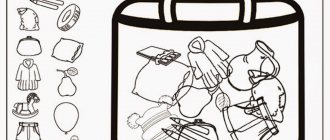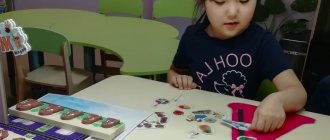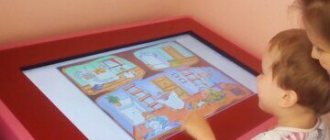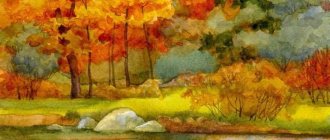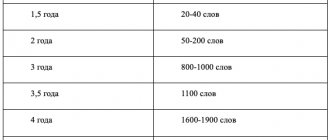MADOOU general developmental kindergarten No. 422 “Lorik”, Yekaterinburg
Parents are recommended:
- consider insects (bee, ant, grasshopper, dragonfly, butterfly, ladybug, fly, mosquito, spider),
- discuss their appearance, highlight parts of the body: head, wings, abdomen, antennae, legs,
- tell the child what benefits (harm) insects bring, teach the child to respect nature.
On the topic, children should know:
- names of insects (bee, wasp, bumblebee, fly, snail, dragonfly, grasshopper, worm, ladybug, etc.), insect body parts (sting, wings, proboscis, abdomen, paws...),
- what benefits and harm do insects bring?
- what insects eat (nectar, other insects, human food remains)
Materials for familiarization with the topic:
Let's get acquainted with insects in the presentation: https://cloud.mail.ru/public/3PJV/2eeFYrpMX
Watching insects in a beautiful video: https://cloud.mail.ru/public/2H54/5CNYv2QQE
Speech development tasks:
- “Pick up a word.” Selection of verbs for the word insects: What do insects do? they fly, flutter, crawl, jump, suck, bite, sting, collect, drink, buzz, ring, buzz, bother, harm, help, fly over, hide, fall asleep, wake up, crawl out, work, carry.
- “Call it affectionately”: spider - spider, mosquito - ..., cockroach - ..., bee - ..., fly - ..., beetle - ..., dragonfly - ...
- “Change the word”: a yellow butterfly is yellow, a white butterfly is white.
Change this way: black ant, gray mosquito, red ladybug, blue beetle, green grasshopper, striped wasp.
- “Whose paws, whose head?”
An ant has ant legs and an ant head. The bee has ……… legs, …….. head. A mosquito has …….. legs, ……… head. The cockroach has …… legs, …….. head. The spider has ………… legs, ……. head.
- “Giant insects”: the use of words with magnifying connotations. A spider is a spider, a beetle is a bug, an ant is ..., a mosquito is ..., a worm is ..., a bumblebee is ..., a bug is ...., a cockroach is .....
- “Who moves how?” Composing complex sentences with the meaning of opposition. The child not only selects the right word, but also repeats the entire sentence.
An ant crawls, and a butterfly... A caterpillar crawls, and a grasshopper... A butterfly flies, and a snail... A beetle crawls, and a dragonfly... A wasp flies, and a worm... A snail crawls, and a dragonfly... A spider crawls, and a bee... A wasp flies, and a worm... A grasshopper jumps , and the mosquito... The cockroach crawls, and the dragonfly... The butterfly flutters, and the fly...
- Retell the story “Centipede” using reference pictures:
Once upon a time there lived a centipede. She was going to visit. She looked out the window. And it's raining outside. The centipede began to put on rubber boots. While forty legs were shod, the sun began to shine. The centipede began to take off its boots. While I was taking everything off, it began to snow. The centipede decided to wear felt boots. By the time forty feet were shod, winter was over. Since then, the centipede has been walking barefoot.
- The game “it happens - it doesn’t happen”: understanding logical and grammatical structures.
A girl catches a butterfly. The girl is caught by a butterfly. A butterfly is caught by a girl. The butterfly catches the girl. The girl caught a butterfly. The butterfly caught the girl, etc.
- Complete the sentences:
Maxim holds a spider in his palm, although...... (although he is afraid of them, although it is a dangerous spider, etc.) Katya saw a butterfly on the street, although.... (although it was still early spring, late autumn) The butterfly flew away, although... ..
- Count the insects (agreeing nouns with numerals): one fly, two flies... five flies.
- Solve the crossword puzzle
- Game "Who flies to whom"
Developmental tasks
A task to develop fine motor skills of the fingers. Learning to cut.
Print out the insects page for kids and have them cut along the dotted lines.
Introduce your child to the insects in the picture, discuss which ones fly, which ones crawl, which ones live underground, which ones live in the sky and on the ground, what these insects eat, what benefits they bring to people, etc.
Learning to count with insects for children.
Learning to count by tens. Cut into cards and count with your child.
Logical game with insects for children.
Build a logical chain of beetles. Cut out cards with beetles separately and invite your child to continue the logical chain with insects for children.
Here you need to circle the dotted lines.
A game to develop fine motor skills of a child's fingers.
We compose a story based on pictures about insects for children. Poems and stories about insects can also help here.
A game to develop speech in children.
Insect cube for children. Creative task. Print, cut the cube and glue it together with your child. Now you can play. Throw the dice and name the insect that the child comes across.
A game to develop fine motor skills of the fingers. Here you need to draw a dotted line and help the insects get to the leaves.
Creative activity with a caterpillar for children. These are coloring pages where you need to paint a cute insect caterpillar for children. Coloring pages are very useful: they develop fine motor skills and prepare the hand for writing.
We teach the correct use of prepositions with children. Card game with insects for children.
We learn prepositions FOR, ON, NEAR.
Learning to sort insects.
Montessori sorting game. Cut the cards and sort insects and flowers into 2 columns.
Here you need to find geometric shapes hidden in insects and plants.
A game to develop mindfulness. Here you need to find the extra object in each line.
Mathematical and attentive game: “Where is the dragonfly hiding?”
Print out the material, cut it into cards, hide, for example, a dragonfly under a piece of paper with number 1, so that it is slightly visible, and ask the child what number the dragonfly is hiding under the piece of paper with which number, etc. If the child does not yet know the numbers, you can simply hide the dragonfly and find it yourself and say under which leaf it was hidden. A very good, exciting game for developing mathematical abilities.
Puzzles
They will help develop ingenuity and intelligence. Riddles are a description by which you need to guess about an insect.
Interesting Facts
encyclopedia. Here is a collection of fascinating information about insects. A children's encyclopedia and fun facts will be useful for children's erudition.
Poetry
They will help to interest the baby and promote speech development.
A selection of good riddles about insects for children.
Fairy tales
Many fairy tales have been invented about insects, among the most famous are “The Cockroach”, “The Cluttering Fly”, “How an Ant Hurried Home”, “Luntik”, “The Tale of a Little Boat” and others.
Here is a modern fairy tale about a snail:
Videos and presentations
It can be used both in a lesson at school and in kindergarten.
Presentations about insects:
- bloodsucking,
- homemade,
- bees and ants
Coloring pages
Coloring page with insects in English.
How to mold from plasticine?
Detailed instructions on how to make insects from plasticine - a grasshopper and a beetle (step by step):
Crossword
Summary of a lesson on familiarization with the outside world in the preparatory group on the topic: Insects
Summary of a lesson on familiarization with the outside world in the preparatory group on the topic: “Insects.”
Author: Marina Mikhailovna Platnova, teacher, Moscow State Budgetary Educational Institution “School No. 285 named after V.A. Molodtsova" structural unit No. 14. Description of the material: I bring to your attention a summary of a lesson on speech development and familiarization with the outside world for children in the preparatory group of kindergarten. This methodological development may be useful for preschool teachers and parents. Goal: Expand and clarify children's knowledge about insects. Objectives: - To clarify children’s knowledge about insects (appearance, behavior in nature). — Develop dialogic monologue speech of children. — Cultivate a caring attitude towards insects. Material for the lesson: pictures of insects.
Progress of the lesson
-Guys, let's play the guessing game. - Guess the riddles. (Guessing pictures are put on the board). -From a branch to a path, from a path to a blade of grass. Is the spring jumping, the green back? ( Grasshopper)
-This Ivashka has a red shirt. Are there black dots on the back of the shirt? (Ladybug)
— The blue airplane landed on a yellow dandelion? (Dragonfly)
-It flutters and dances over the flower, waving its patterned fan. (Butterfly)
- Cheren, but not a raven, horned, but not a bull, six legs, but all without hooves? (Bug)
— It buzzes over the table, flies around, and really bothers everyone? (Fly)
- In the forest near the stump there is bustle, running around, people working all day long? (Ant)
- Ju-ju-ju! I'm buzzing over the flowers! I’ll work on the flower - Will I please you with honey? (Bee)
How can you call everyone in one word? That's right, insects. Insects are the most numerous and diverse class of the animal world. On land they live on all continents, with the exception of the Arctic and Antarctic. One of the characteristic differences between all insects is three pairs of legs (they are also called six-legged), so spiders, for example, do not belong to the class of insects. - At what time of year can we see them in nature? (Spring, summer, autumn). - Why are insects needed? (They pollinate plants and are food for birds and animals) - Guys, show me the body parts of insects.
(Head, antennae, proboscis, eyes, abdomen, wings, legs) - Tell us about the benefits insects bring. — To people: bees give honey and wax. — Forest: ants, ladybugs destroy harmful insects. — Birds and animals: insects serve as food. — Tell us about the harm insects cause. — For people: flies, cockroaches, mosquitoes bite painfully and spread dangerous diseases. — Forest: bark beetles damage the bark of trees, caterpillars eat the leaves of plants. — Animals and birds: mosquitoes, horseflies, fleas bite painfully. - Now let’s play the game “Call it affectionately” Komar-komarik. Dragonfly-... Cockroach-... Bug-... Bee-... Fly-... I explain to the children the concept of “predatory insects” (dragonfly, ant, ladybug, grasshopper). For example: a dragonfly feeds on mosquitoes and midges, which they grab on the fly like swallows. Large dragonflies can attack tadpoles and fish fry. — The most beautiful insects are butterflies. They live wherever there are plants. Butterflies can be large, even gigantic, the size of a bird, and small, the size of a fingernail. — Beetles live not only on land. The swimming beetle is a predatory beetle that can be found in almost every body of water. Swimming beetles attack insects that live in water, tadpoles and even fry of small fish. Their larvae are also predators. Having grabbed onto a tadpole or fish, they gradually eat part of the body of their victim, who drags the voracious bug along with her everywhere. — Flies and mosquitoes feed only on liquid food. Mosquito larvae live in water, while adult mosquitoes live in the air. The male mosquito is completely harmless; it feeds on plant sap and sweet nectar. Only females bite us. To lay eggs, they must drink blood. — Bees live in large families. A bee colony consists of one queen, who lays eggs, and several thousand worker bees. Each member of the colony performs its own duties: young bees clean the hive, build honeycombs, take care of the larvae, and then begin to fly out of the hive in search of pollen and nectar. - Ants also live in families in complex nests in the ground, under stones and in ground anthills, which they build from dry branches and pine needles. The family includes wingless working females, winged males and female founders (queens), who lay eggs and live for a very long time, up to 20 years. The main food for ants is other insects and plant seeds. — Guys, let's play the game “Give me a word.” — A dragonfly has eyes, not eyes. - The ant does not have legs, but... - The cockroach does not have a mustache, but... - The butterfly does not have a wing, but... - Has our lesson come to an end? — What types of insects do you remember? - Well done boys.
We recommend watching:
Summary of a lesson on speech development in the preparatory group. An environmental project in the senior group on the topic: Insects. An educational project in kindergarten “Insects” for children of the senior group. Synopsis of educational activities for children of the preparatory group in kindergarten with a presentation. Insects
Similar articles:
Lesson summary for the senior group on the topic: Insects and flowers
Poems about insects for preschool children 5-6 years old
Conversation about the caterpillar for children
About beetles for children 5-8 years old
About mosquitoes for children
Lexical topic “Insects” (senior group)
Vocabulary work
Nouns:
Beetle, butterfly, fly, ladybug, ant, mosquito, grasshopper, dragonfly, insect;
Head, mustache, body, paws, wings, sting, eyes, notches, pollen, beehive, nectar, anthill.
Adjectives:
Beautiful, colorful, yellow, shaggy, hardworking, shiny, black, brown, bright, caring, beautiful, light, harmful, useful.
Verbs:
Fly, crawl, work, pollinate, eat, crawl out, burrow, buzz, bite, sting, squeak, chirp, harm.
Adverbs:
High, low, far, close, beautiful, fun, noisy.
Prepositions:
Above, under, before, around, behind.
Finger gymnastics:
A striped bee flew to us yesterday (Waving their palms), (They bend a finger for each insect) And behind her a bumblebee And a cheerful moth, Two beetles and a dragonfly, Eyes like lanterns. (They make rings and bring them to their eyes) The ants came and brought a blade of grass. They buzzed, flew, (Waving their palms) They fell from fatigue. (Palms drop on knees)
Articulation gymnastics:
Horse, Mushroom, Clock, Chatterbox, Cup - Shovel.
Breathing exercises:
Blow an insect off your hand.
Lexico - grammar games
"Who is this?"
— Examination of insects and their body parts. — Guessing riddles about insects. — The general concept of “Insects” — The harm and benefits of insects.
"Pick up a word"
What butterfly? – beautiful, colorful, light, fast... Ant – Bee – Mosquito – Ladybug – May beetle – Grasshopper – Dragonfly –
"Pick up a word"
What is the butterfly doing? – flies, pollinates, hides... Ant – Bee – Mosquito – Ladybug – May beetle – Grasshopper – Dragonfly –
"Say kindly"
Ant - ant Dragonfly - Beetle - Whiskers - Fly - Wings - Mosquito - Eyes -
"One is many"
Beetle – beetles Butterfly – Fly – Ladybug – Ant – Mosquito – Grasshopper – Dragonfly – Insect – Whisker – Wing – Beehive –
Say with the word "a lot":
Lots of beetles, ants, flies, insects,...
"What is he doing? - What are they doing?
The beetle flies - beetles fly crawls - crawls squeaks - squeaks pollinates - pollinates stings - stings eats - eats buzzes - buzzes crawls out - crawls out flies away - flies away bites - bites works - works
"Where is the butterfly?"
- ON the flower, ABOVE the flower, BEFORE the flower, NEAR the flower, BEHIND the flower.
“Who is screaming?”
Mosquito - squeaks Fly - buzzes Grasshopper - chirps
Development of coherent speech
Write a descriptive story about an insect (with the help of leading questions from an adult).
1. Who is this? 2. Body parts 3. Color 4. Where does it live? 5. Does it bring benefit or harm?
Memorizing poems
1. I found myself a beetle on a large daisy. I don’t want to hold it in my hand, let it sit in my pocket.
Six legs, two eyes, a speck on the back. This is good grass. Here, eat some blades of grass.
Oh, I fell, fell out of my hands, My nose got dirty with dust. The green beetle flew away, flew away on wings.
2.- Where have you been? - Here and there. - Where did you fly? — By colors. -What did you bring home? “Honey,” answered the bee.
Teacher-speech therapist Buzmakova Anastasia Fedorovna Teacher-speech therapist Bugrova Elena Gennadievna city of Perm
- Summary of a group lesson in a senior speech therapy group on the topic “Insects”
- Lexical topic “Fruits” (senior group)
- Speech therapy exercises on the topic “Insects”
- Lexical topic: “Clothing. Shoes. Hats"
- Lexical topic “Food”
( 2 liked, average score: 5.00 out of 5)
Loading...
Games with cards "insects"
If you show a little imagination, you can come up with many interesting, educational games for children using pictures of insects.
You can play with the cards: let the little entomologists take turns pulling them out and calling the insect that came across. It will be very good if they can retell what you said about this insect.
If you print out two cards of each insect, you can play a game like Memorina. To do this, all the cards are laid out on the table with the side without the pattern facing up. Each child can turn over two cards one at a time. If the pictures match, you can take them for yourself. If not, we put it exactly in the place where we took it. Then the next child turns over the cards, and so on in a circle. The game is considered complete when all the cards are dealt with. The winner is the one who collected the most paired pictures. This exciting activity is great for developing memory.

